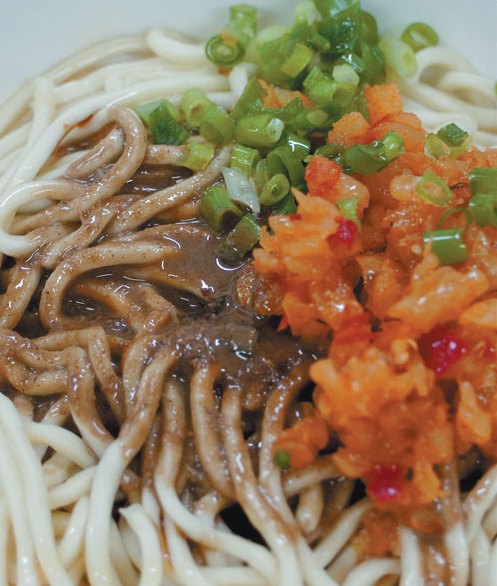Heritage on a plate
By Ye Jun ( China Daily USA )
Updated: 2014-03-06
Chinese food joins the crowd of cuisines seeking global status as a UNESCO intangible cultural heritage, Ye Jun reports.
China has a rich food culture, with many dishes nationally famous and part of the country's intangible cultural heritage. However, none of them has made it on UNESCO's list. Industry experts have been preparing material about Chinese cooking techniques and traditional banquets, hoping to make a breakthrough application next year.
Kimjang, the making and sharing of kimchi in Korea, has already won a spot on the list of UNESCO's world intangible cultural heritages. Washoku, traditional Japanese cuisine, and ancient Georgian traditional qvevri wine-making culture was also added to the list last December during UNESCO's 8th intergovernmental council in Azerbaijan - the same meeting where Chinese zhusuan, traditional calculation by abacus, was listed.
|
Popular Wuhan noodle snack, reganmian, is applying to enter the national intangible cultural heritage list. Ye Jun / China Daily |
Recognition for food-related items is not new. France's multi-course gastronomic meal, with its rites and its presentation, was one of the first to make the list in 2010. Earning UNESCO status at the same time was traditional Mexican cuisine, and the Mediterranean diet of Cyprus, Croatia, Spain, Greece, Italy, Morocco and Portugal.
China has 29 items on UNESCO's Representative List of Intangible Cultural Heritage, and seven items on the list of Intangible Cultural Heritage in Need of Urgent Safeguarding. But none of them are food related.
Bian Jiang, deputy director of the China Cuisine Association, says that is a pity.
"The development of Chinese civilization evolved around gourmet culture," Bian says. For example, ding, an ancient cooking vessel with two loop handles and three or four legs, was also a symbol of dynasties in ancient China.
Many important festivals in China are marked with food. Spring Festival starts with a bowl of "eight treasure" congee, followed by the making and eating of jiaozi (boiled dumpling) on Spring Festival Eve and Spring Festival Day, and ends with the eating of yuanxiao, glutinous rice ball on the 15th day of the Lunar New Year.
According to Bian, China's Ministry of Culture contacted the China Cuisine Association in 2011, designating it as "the main body" of application by Chinese cuisine for world intangible cultural heritage status.
Bian says the association put forward written and video materials for "traditional Chinese cuisine cooking techniques", but the ministry still has the application presentation under review.
Bian notes that there are already 50 food-related intangible cultural heritage items recognized on the national level, more than 300 on the provincial level and many more at city and county levels.
In October 2003, UNESCO passed a convention to safeguard intangible cultural heritages. Meanwhile, China issued instructions to protect them nationally. Since then, food-related cultural heritage has been one of the most active categories in application.
Two dishes currently seeking recognition at the national level are reganmian, hot dry noodles, a snack food in Wuhan, Hubei province, and Chongqing's hotpot.
"Reganmian is an important part of Wuhan local breakfast. It is what Wuhan people grow up eating," says Liu Wuhan, executive chef with Xiang'Eqing's Dinghuisi branch in Beijing.
Reganmian noodles contain sodium carbonate. They offer a special taste because they are dried and then boiled, and served with fragrant sesame oil and sesame paste. Xiang'Eqing, a restaurant specializing in Hubei and Hunan cuisines, sells more than 200 bowls of the noodles a day during their busy periods.
"Local Wuhan people will miss the taste of reganmian if they don't eat it for two days. It is an eating habit passed down for several generations," says Lu Yongliang, Hubei cuisine master chef. "But people in other areas are likely to find the noodles a bit dry."
Lu says if reganmian succeeds in its bid for national recognition, it could spread throughout the country. The effort of the local government to protect regional culture will help the noodle-making technique pass down to the next generation.
Bian is also a judge on a board to decide which items can make it into a national intangible cultural heritage list. He says a successful applicant must be a technique or custom with a long historical and traditional background, at least 50 years old. Then it must have inheritors, so that the technique or custom can be protected.
Reganmian and Chongqing hotpot are part of the fourth round of applications for national recognition, a process that begins every two years. Among the first three groups of successful applications there are 50 food-related ones.
Many of these are nationally famous baijiu (clear liquor) brewing, such as Moutai and Wuliangye, and tea-making techniques, including green tea, black tea, oolong and Pu'er. Peking roast duck skills, like those of Quanjude and Bianyifang restaurants, are on the list. Luoyang's "water banquet" preparation, Sichuan Fuling's zhacai, and Confucius family cuisine preparation are all listed as national intangible cultural heritage.
In China, an application has to achieve county, city and provincial recognition before getting to the national level.
Bian is convinced that intangible cultural heritage status will help raise the international image of Chinese cuisine, and promote the development of the Chinese food industry. It will help Chinese restaurants to develop overseas.
He says his association has done a lot of work in this aspect. But more remains to be done.
"In order to make the application successful, we need more financial support," he says. "On the other hand, a successful application has to be launched from the national level, as France and South Korea have done. Hopefully we can make a breakthrough with our application in 2015."
Contact the writer at yejun@chinadaily.com.cn.
(China Daily USA 03/06/2014 page10)




